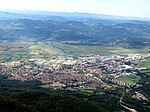Municipality of Ajdovščina

The Municipality of Ajdovščina (pronounced [ˈaːi̯dɔu̯ʃtʃina]; Slovene: Občina Ajdovščina) is a municipality with a population of a little over 19,000 located in the Vipava Valley, southwestern Slovenia. The municipality was established in 1994. Its seat is in the town of Ajdovščina. As of 2020, its mayor is Tadej Beočanin.Ajdovščina is part of the Slovene Littoral traditional region as well as modern Gorizia statistical region. The climate is influenced by the Mediterranean (minimum temperature in winter −1 °C (30 °F), maximum 17 °C (63 °F); in the summer time maximum temperature 39 °C (102 °F), minimum 20 °C (68 °F). Its characteristic is the bora wind, which may reach the speeds over 200 kilometres per hour (120 mph).
Excerpt from the Wikipedia article Municipality of Ajdovščina (License: CC BY-SA 3.0, Authors, Images).Municipality of Ajdovščina
Pot v Žapuže,
Geographical coordinates (GPS) Address Nearby Places Show on map
Geographical coordinates (GPS)
| Latitude | Longitude |
|---|---|
| N 45.883333333333 ° | E 13.916666666667 ° |
Address
Pot v Žapuže 14
5270 , Šturje
Slovenia
Open on Google Maps





